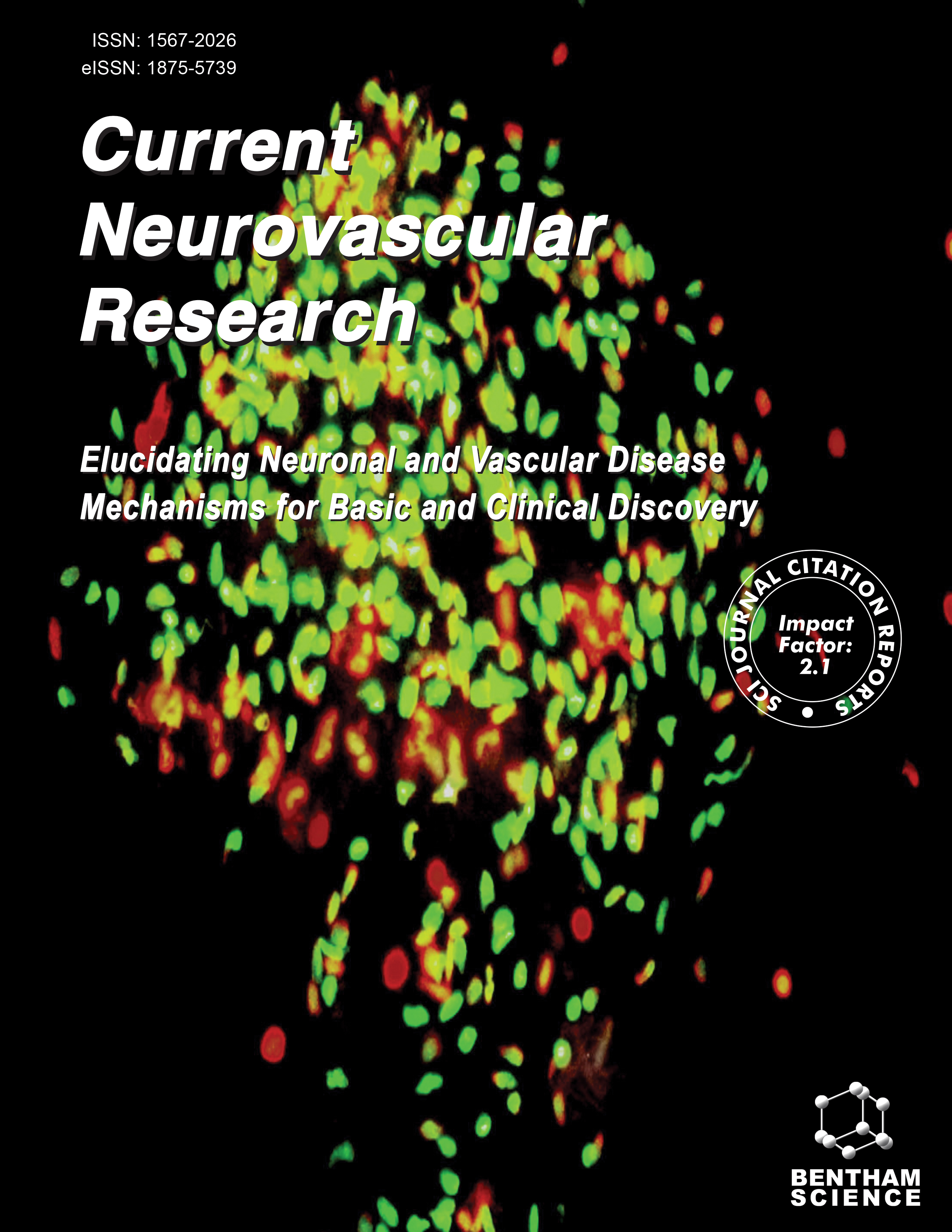- Home
- A-Z Publications
- Current Neurovascular Research
- Previous Issues
- Volume 2, Issue 3, 2005
Current Neurovascular Research - Volume 2, Issue 3, 2005
Volume 2, Issue 3, 2005
-
-
Increasing Expression of Heme Oxygenase-1 by Proteasome Inhibition Protects Astrocytes from Heme-mediated Oxidative Injury
More LessAuthors: Jing Chen and Raymond F. ReganHemin is released from hemoglobin after CNS hemorrhage, and may contribute to cell loss in surrounding tissue. Heme oxygenase-1 (HO-1) is induced by these injuries, and may have an effect on cell viability. In a prior study, we reported that increasing HO-1 expression by adenoviral gene transfer prior to hemin exposure attenuated oxidative stress and cell death in astrocytes. However, rapid gene transfer to the CNS may Read More
-
-
-
mGluRI Targets Microglial Activation and Selectively Prevents Neuronal Cell Engulfment Through Akt and Caspase Dependent Pathways
More LessAuthors: Zhao Z. Chong, Jingqiong Kang, Faqi Li and Kenneth MaieseMetabotropic glutamate receptors (mGluRs) are expressed throughout the mammalian central nervous system and integrate a host of signal transduction pathways that determine cellular function, plasticity and injury. Yet, one of the more unique regulatory functions of this family of GTP-binding proteins involves cytoprotection in the nervous system. Here, we demonstrate that activation of group I metabotropic glutamate Read More
-
-
-
Neuronal and Glial Responses to Polyamines in the Ischemic Brain
More LessAuthors: Katsura Takano, Masato Ogura, Yoichi Nakamura and Yukio YonedaThe polyamines, putrescine, spermidine and spermine are present in most living cells, with the essentiality for normal cell function, cellular growth and differentiation. In the mammalian brain, polyamines are also present at relatively high concentrations with different regional distribution profiles. Cerebral ischemia is a leading cause of disability and mortality in humans, and believed to yield a cascade of cytotoxic molecule Read More
-
-
-
Relaxin in Vascular Physiology and Pathophysiology: Possible Implications in Ischemic Brain Disease
More LessAuthors: Silvia Nistri and Daniele BaniThe hormone relaxin, known for its action on the female reproductive tract, is also able to act on organs and systems different from the reproductive ones, including the blood vessels, the heart and the brain. Relaxin causes vasodilation in several organs stimulating the biosynthetic pathway of nitric oxide (NO), a potent vasodilator. Relaxin also has a cardioprotective action: it reduces the inflammatory activation of n Read More
-
-
-
Recent Progress in Cerebrovascular Gene Therapy
More LessAuthors: Naoyuki Sato, Munehisa Shimamura and Ryuichi MorishitaGene therapy provides a potential strategy for the treatment of cardiovascular disease such as peripheral arterial disease, myocardial infarction, restenosis after angioplasty, and vascular bypass graft occlusion. Currently, more than 20 clinical studies of gene therapy for cardiovascular disease are in progress. Although cerebrovascular gene therapy has not proceeded to clinical trials, in contrast to cardiovascular gene t Read More
-
-
-
Role of Kynurenines in the Central and Peripherial Nervous Systems
More LessAuthors: Hajnalka Nemeth, Jozsef Toldi and Laszlo VecseiKynurenine (KYN) is an intermediate in the pathway of the metabolism of tryptophan to nicotinic acid. KYN is formed in the mammalian brain (40%) and is taken up from the periphery (60%), indicating that it can be transported across the blood-brain barrier (BBB). In the brain, KYN can be converted to two other components of the pathway: the neurotoxic quinolinic acid (QUIN) and the neuroprotective kynurenic acid (KYNA Read More
-
-
-
Ferric Cycle Activity and Alzheimer Disease
More LessAuthors: Barney E. Dwyer, Atsushi Takeda, Xiongwei Zhu, George Perry and Mark A. SmithElevated plasma homocysteine is an independent risk factor for the development of Alzheimer disease, however, the precise mechanisms underlying this are unclear. In this article, we expound on a novel hypothesis depicting the involvement of homocysteine in a vicious circle involving iron dysregulation and oxidative stress designated as the ferric cycle (Dwyer et al., 2004). Moreover, we suspect that the development o Read More
-
Volumes & issues
-
Volume 21 (2024)
-
Volume 20 (2023)
-
Volume 19 (2022)
-
Volume 18 (2021)
-
Volume 17 (2020)
-
Volume 16 (2019)
-
Volume 15 (2018)
-
Volume 14 (2017)
-
Volume 13 (2016)
-
Volume 12 (2015)
-
Volume 11 (2014)
-
Volume 10 (2013)
-
Volume 9 (2012)
-
Volume 8 (2011)
-
Volume 7 (2010)
-
Volume 6 (2009)
-
Volume 5 (2008)
-
Volume 4 (2007)
-
Volume 3 (2006)
-
Volume 2 (2005)
-
Volume 1 (2004)
Most Read This Month
Article
content/journals/cnr
Journal
10
5
false
en


